What is an exoskeleton?
The field of exoskeleton systems is continuously evolving and re-inventing itself, so it is still difficult to create a singular definition. In general:
- Exoskeletons are wearable devices that work in tandem with the user. The opposite of an exoskeleton device would be an autonomous robot that works instead of the operator.
- Exoskeletons are placed on the user’s body and act as amplifiers that augment, reinforce or restore human performance. The opposite would be a mechanical prosthetic, such as a robotic arm or leg that replaces the original body part.
- Exoskeletons can be made out of rigid materials such as metal or carbon fiber, or they can be made entirely out of soft and elastic parts.
- Exoskeletons can be powered and equipped with sensors and actuators, or they can be entirely passive.
- Exoskeletons can be mobile or fixed/suspended (usually for rehabilitation or teleoperation).
- Exoskeletons can cover the entire body, just the upper or lower extremities, or even a specific body segment such as the ankle or the hip.
In summary, robotics is the application of engineering towards replacing humans with menial tasks, while exoskeletons are the application of robotics and biomechatronics towards the augmentation of humans in the performance of a variety of tasks.
Exoskeletons can also be referred to as robotic suits, powered armor, exo-frame or exosuits, wearable machines, power jackets, etc… Deriving a simple definition of what an “exoskeleton” is can be quite tricky.
Background:
Back around 2010, there were only a handful of wearable exoskeleton devices that were known to the public. For the nonfictional, they were the HULC, HAL, XOS, ReWalk and for the fictional ones, there were the Power Loader from Aliens and Iron Man. At the time, all fictional and nonfictional wearable robotic devices shared the same architecture: large, rigid metal frames that went all the way to the ground and had sizable actuators.
There were different names thrown around for this new family of fictional and real devices. For example, a “biomechatronics” device, the combination of biology, mechanics, and electronics gained a lot of popularity for a while but just didn’t stick (fun fact, the first version of the Exoskeleton Report was Biomechatronics.net). Instead, the term “Powered Exoskeletons” gained popularity. “Powered” differentiated it from insect exoskeletons, and “exoskeleton” was appropriate for the large and bulky devices and was a wonderful play on “endoskeleton” from the Terminator movie franchise.
Fast forward a few years, however, and researchers began to popularize passive exoskeletons, wearable devices that had no motors or controllers that still performed useful physical work. Just like that, PoweredExoskeletons.com (another early version of the Exoskeleton Report) became obsolete! So did the term “Powered Exoskeletons,” as now not all exoskeletons provided active force or torque. “Powered Exoskeleton” became shortened to “Exoskeleton,” which generated confusion between insect and wearable exoskeletons but it was still a good term to describe the devices. There are more than a dozen wearables tagged as “passive” in the Exoskeleton Catalog, link.
Then, along came projects like the Wyss Institute exosuit which showed that wearable exoskeletons do not have to be rigid or extend all the way to the ground. This was a big departure from previous power suits and while they were not the first, the research at the Wyss Institute really popularized this approach. But this exciting development presented a conundrum, an “exoskeleton” is something that would be normally hard and rigid, the very opposite of a soft exosuit.
At the time, the solution seemed easy, just rename all “exoskeletons” to “exosuits” since an exosuit can be soft or rigid (example, a suit of armor). But, this solution was a no-go from the beginning, as soft exosuits brought with them localized exoskeletons that covered only one segment of the body. Initially, there were only power gloves, but now there is a myriad of wearables that cover only one part of the body (refer to Introduction to the Commercial Exoskeletons Catalog).
The best solution was still to group (force) soft exosuits with exoskeletons by making them a subcategory. Thus, “exoskeletons” became:
All right! Problem solved! As long as the soft wearables can be inserted as a variation on the original rigid design, all is well with the terminology. And then along came functional electric stimulation or FES (see Electrical Muscle Stimulation in Rehabilitation, Cybernetic Bicycles and Exoskeletons). FES uses already existing muscle groups as actuators, regardless of whether the user (client) can activate those muscle groups by themselves or not. Here is where things get confusing:
If we just focused on a single body part, let’s say the ankle, what would you consider to be an exoskeleton? Take a look at these five ankle wearable devices: REX, Passive Ankle Exoskeleton, SaeboStep, Bioness L300, Foot Orthosis.
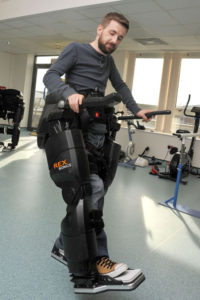
REX by Rex Bionics
The REX exoskeleton is clearly an exoskeleton. The REX is a rigid frame wearable device with motors and sensors. The REX is so powerful, it can move a person entirely on its own.
Verdict:
Exoskeleton – Powered
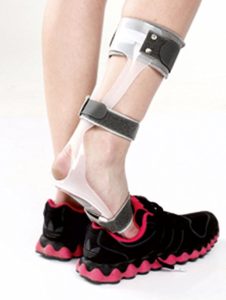
Foot Drop Splint
How about a food drop orthotics? Would that be an exoskeleton? This is another freebie. It is clearly not an exoskeleton. While it is a wearable and rigid, a splint falls within the well-established field of braces. It has no motors, sensors, or spring elements.
Verdict:
Not an exoskeleton.
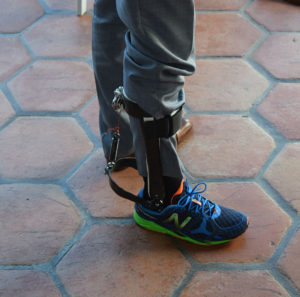
Passive Ankle Exoskeleton
The Passive Ankle Exoskeleton is structurally similar to the foot drop brace (above), but it has a hinge at the ankle, a spring and a clutch. All moving components are optimized and synchronized to decrease the metabolic cost while walking. For more, see Greg Sawicki on Successfully Reducing Walking Metabolic Cost.
Verdict:
Exoskeleton – Passive
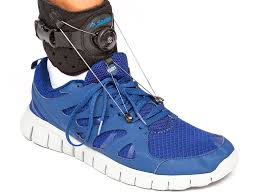
SaeboStep by Saebo
The SaeboStep is designed to be a replacement to the classic foot drop splint. Rather than having a rigid orthotic that enters inside the shoe, the foot is supported by a thin cable. The cable length is adjustable, similar to a ski boot.
Is this an exoskeleton? The core Exoskeleton Report team put this up for an internal discussion at the end of 2016 and decided that this is not an exoskeleton. However, the Wearable Robotics Association does list this family of wearables as exoskeletons (see WearRA slides).
Verdict:
Exoskeleton Report: No, this is not an exoskeleton.
WearRA: Yes, this is an exoskeleton.
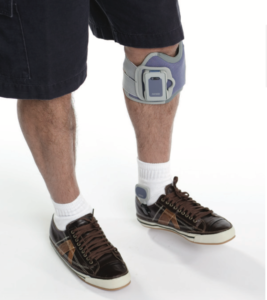
L300 Foot Drop System by Bioness
Now let’s add another level of complication. Is the L300 an exoskeleton? The L300 is a foot drop prevention system that uses the client’s own muscles as actuators. A foot sensor below the heel and at the ankle monitor the position of the leg and the phase of the gait cycle. A leg brace below the knee utilizes functional electrical stimulation (FES) to activate the muscle groups responsible for raising the foot. A controller (off picture) handles the wireless communication between the components. In addition, the L300 can be expanded to include other joints in the leg.
So is this an exoskeleton!? There is no hard frame, no wires running up and down and no springs, motors, hydraulics or inflatables other than the already existing muscle groups to generate movement. Can a dormant muscle already existing in the body that is activated externally be considered as the “actuator” for an “exoskeleton” device? What if the controller and sensors were implanted below the skin?
Verdict: unknown
At this point, it is clear that in the first quarter of 2017 what is an “exoskeleton” is murkier than ever. It is not the fault of the term. As you saw, originally an exoskeleton stood for more than 90% of all devices being developed. With more research going into the field, however, the new solutions to old problems are becoming more and more distant from the original motorized rigid metal wearables. Keeping everything under the same umbrella term is becoming more challenging.
One option would be to retire the term and find the commonality between all old and new wearable projects. They have to be external, so no limb replacements or prosthetics. They have to exert an active, physical force on the user. So perhaps a merger of the terms “external” and “force” would be more accurate, for example, exoforce, external kinetic device (EKD), exovirium (from latin) or exomotus (again from latin).
Enter Hollywood
Perhaps attempting to changing the term exoskeleton to something more inclusive is too late. Popular culture has always had an impact on what people expect from technology (think original Star Trek and cell phones). Hollywood has taken a liking to wearable robotics and the term exoskeleton. New movies such as Elysium, Avatar, Edge of Tomorrow, GI Joe, and Prometheus have solidified the term “exoskeleton” into popular culture.
Why does it matter?
Having a single term that encompasses what the industry is about is critical for communication. Take David Cohen’s patent research: An Overview of the Exoskeleton Patent Landscape. There are patents for all manners of exoskeleton devices that use all kinds of names and designations, sometimes as non-descript as simply “robot.” So creating a full analysis of the patent landscape for the exoskeleton industry will require dozens of search terms seeking the same thing. This is very inefficient. The same challenge is encountered by insurance companies, investors, hobbyists and medical and industrial professionals when they search for information on wearables. The same type of device can have completely different names based on the manufacturer’s preference. This hinders information gathering and needlessly complicates communications.
What is being done?
NIST has initiated a terminology task group right after the Exoskeleton Technical Interchange Meeting in January 2017. In addition, the Wearable Robotics Association will be holding its second conference, WearRAcon17 this April, 2017. This is a critical time for the industry to come together and discuss topics such as terminology. There is still a window of opportunity to change terms before they become firmly baked in popular culture. As you can see, the very definition of what is and isn’t part of the exoskeleton industry remains unclear. This is an exciting time for the industry and everyone should participate if they want their voice to be heard.
What is your take on what should and should not be an “exoskeleton?” Don’t hesitate to use the comment field below and share your thoughts.








Here are my exoskeleton subcategories:
Active: meaning that the exoskeleton is powered
Bionic: meaning that the exoskeleton gives extra-human abilities
Linked: meaning that there is an interface the operator uses, compared to full autonomy.
Exosuit: a full body (encapsulated) exoskeleton.
—
under these guidelines:
T.A.L.O.S. would be a active linked bionic exosuit
Ekso GT would be a active semi-autonomous exoskeleton.
REX would be an active linked exoskeleton
Active ankle braces would be bionic exoskeletons
Passive ankle braces like the Saebo would be simply, exoskeletons
Whereas the L300 would be a semi-active exoskeleton
I would call the the foot drop splint a basic exoskeleton too, in the same category as the saebo. It’s not linked, active, or autonomous, but it still fits the definition of exoskeleton.
Thanks for the input Tim!
Some other suggestions I have heard in discussions this week:
Physical Assistive Wearable Device (PAWD)
External Mobility Assistant Device (EMAD)
Great article. I am working at Jonathan Bar-Or Industrial Design. We were involved in the design & development of two products features in this article. L300 By Bioness, and ReWalk exoskeleton.
Small world! Not many people have worked on two wearable projects of this scale and popularity. Your involvement with both the ReWalk and L300 gives more weight to the argument that they are both exoskeletons. As a person with intimate hands-on knowledge with both, what is your take? Are they both “exoskeletons?”
What about the term robotic orthosis?
Thank you for the suggestion. The problem with “robotic” in the name is that passive exoskeletons just don’t qualify as “robots.” So if we were to call them “robotic orthosis” the passive ankle exoskeleton would be bumped out, even though it clearly is an exoskeleton.
I like the idea of keeping the first half “exo” and replace the “skeleton” with what is more accurate. Hence your exoforce would be fine. Keeping even more of the biology reference, exomuscle would be good, but would be awkward when used for the passive braces and of course for the L300.
My proposal is exoact
easy to say, and fuzzy enough to be applicable to both semiactive braces and FES.
Act can be seen as activator, actuator or maybe activity
Hello Johan, thank you for your input. I think that “exoact” is a great idea. The more I think about it however, the more it seems that the L300 FES will not fit. Exoact implies exo-act or external-action. The FES devices are internal-action. The FES only devices like L300 behave like exoskeletons, they collect information from the human body and the environment and provide force to move a human limb, however, the L300 provide an internal force.
I was thinking exoact as in exo-activation in case of FES, because that is what it is about. Or would that be exo-excitation? Hm.
I think that FES technology is moving towards subcutaneous or under the skin sensors. That will eventually make FES devices intra-excitation and intra-force. On the other hand, if exoskeletons utilize sensors that are part of the body, if we define them that the force still has to come from the outside or something on or on top of the skin they will still be an “exo” device.
Perhaps FES devices will remain very close cousins to exoskeletons and exoacts, like trucks are to cars.
I think currentry the tern cybertronics is winning out
Cybertronics is a nice one, it might be a great name for the L300 type of FES devices. wearable robotics, exoskeletons, cybertronics, prosthetics… perhaps we will end up using all of these terms just like car, truck, big rig, automobile…